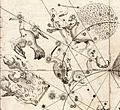Hydrus facts for kids
| Constellation | |

List of stars in Hydrus
|
|
| Abbreviation | Hyi |
|---|---|
| Genitive | Hydri |
| Pronunciation | genitive |
| Symbolism | the water snake |
| Right ascension | 00h 06.1m to 04h 35.1m |
| Declination | −57.85° to −82.06° |
| Quadrant | SQ1 |
| Area | 243 sq. deg. (61st) |
| Main stars | 3 |
| Bayer/Flamsteed stars |
19 |
| Stars with planets | 4 |
| Stars brighter than 3.00m | 2 |
| Stars within 10.00 pc (32.62 ly) | 1 |
| Brightest star | β Hyi (2.82m) |
| Messier objects | none |
| Meteor showers | none |
| Bordering constellations |
Dorado Eridanus Horologium Mensa Octans Phoenix (corner) Reticulum Tucana |
| Visible at latitudes between +8° and −90°. Best visible at 21:00 (9 p.m.) during the month of November. |
|
Hydrus is a small constellation found in the deep southern sky. Its name means "male water snake." This helps tell it apart from Hydra, which is a much bigger constellation representing a female water snake.
You can't usually see Hydrus from most places in the Northern Hemisphere. It stays below the horizon there.
Contents
Discovering Hydrus
Hydrus was one of twelve constellations created by Petrus Plancius. He used observations from explorers Pieter Dirkszoon Keyser and Frederick de Houtman.
This constellation first appeared on a celestial globe in 1597 or 1598. This globe was made in Amsterdam by Plancius and Jodocus Hondius.
The first time Hydrus was shown in a star atlas was in Johann Bayer's Uranometria in 1603. Later, in 1756, the French astronomer Nicolas Louis de Lacaille mapped its brighter stars. He also gave them their official Bayer designations.
Stars of Hydrus
Hydrus might be small, but it has some interesting stars!
Beta Hydri: The Brightest Star
The brightest star in Hydrus is called Beta Hydri. It shines with a brightness of 2.8 magnitude. Beta Hydri is also the closest bright star to the south celestial pole.
Gamma Hydri: A Giant Star
Another cool star is Gamma Hydri. This star is a red giant and is about 60 times bigger than our own Sun. It's a variable star, meaning its brightness changes. It pulsates, or swells and shrinks, causing its brightness to go from magnitude 3.26 to 3.33.
VW Hydri: A Flashing Star
Close to Gamma Hydri, you can find VW Hydri. This star is one of the brightest dwarf novae in the sky. A dwarf nova is a type of star system that suddenly gets much brighter for a short time.
Exoplanets in Hydrus
Scientists have found exoplanets orbiting stars in Hydrus. So far, four star systems in this constellation have planets. One of these is HD 10180, which might have as many as nine planets orbiting it! This makes it a very exciting system to study.
Images for kids
-
Hydrus (lower right) in an extract from Johann Bayer's Uranometria, its first appearance in a celestial atlas.
See also
 In Spanish: Hydrus para niños
In Spanish: Hydrus para niños


